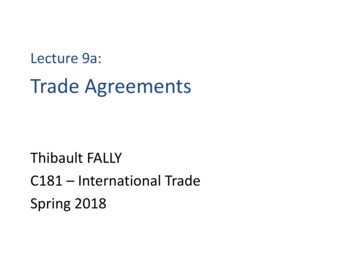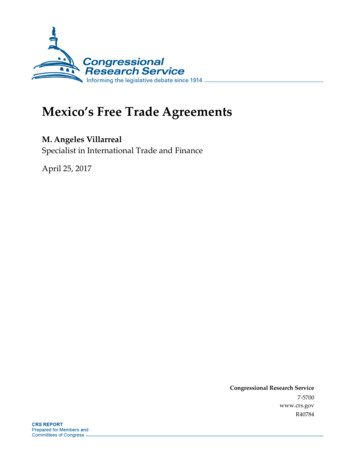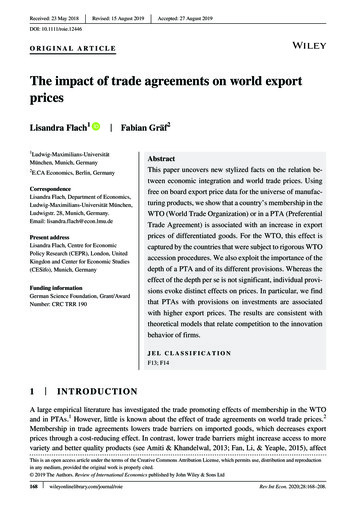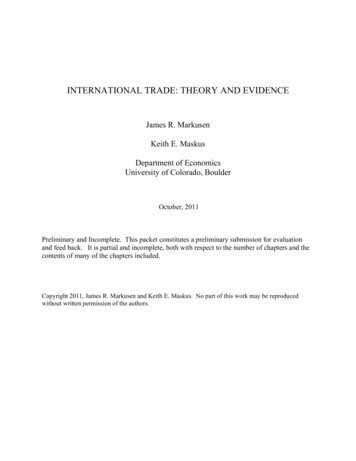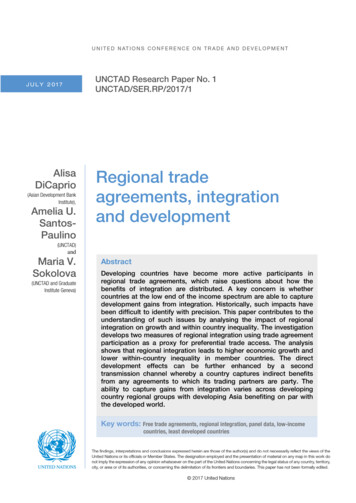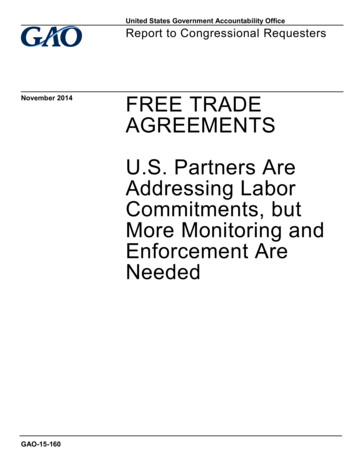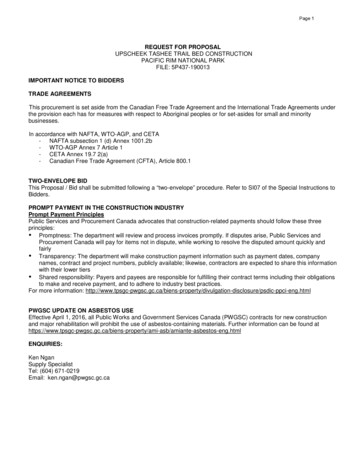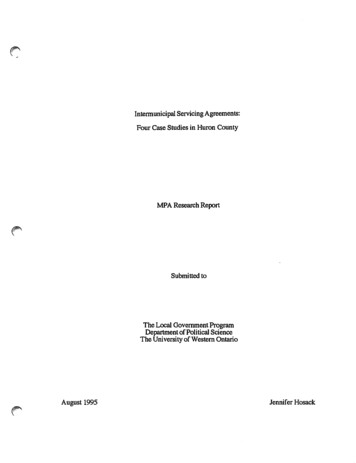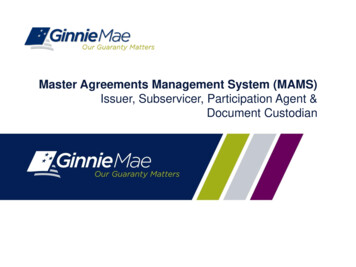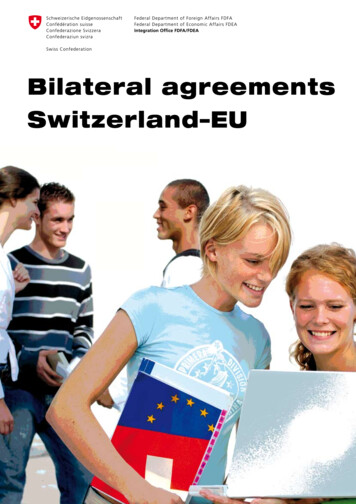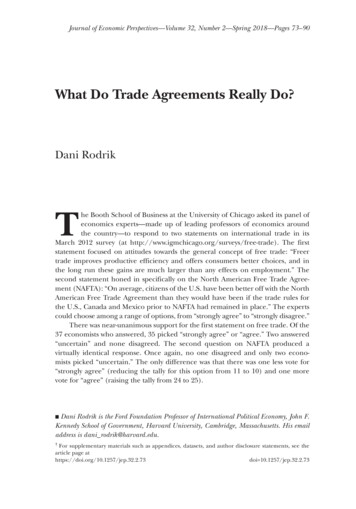
Transcription
Journal of Economic Perspectives—Volume 32, Number 2—Spring 2018—Pages 73–90What Do Trade Agreements Really Do?Dani RodrikThe Booth School of Business at the University of Chicago asked its panel ofeconomics experts—made up of leading professors of economics aroundthe country—to respond to two statements on international trade in itsMarch 2012 survey (at http://www.igmchicago.org/surveys/free-trade). The firststatement focused on attitudes towards the general concept of free trade: “Freertrade improves productive efficiency and offers consumers better choices, and inthe long run these gains are much larger than any effects on employment.” Thesecond statement honed in specifically on the North American Free Trade Agreement (NAFTA): “On average, citizens of the U.S. have been better off with the NorthAmerican Free Trade Agreement than they would have been if the trade rules forthe U.S., Canada and Mexico prior to NAFTA had remained in place.” The expertscould choose among a range of options, from “strongly agree” to “strongly disagree.”There was near-unanimous support for the first statement on free trade. Of the37 economists who answered, 35 picked “strongly agree” or “agree.” Two answered“uncertain” and none disagreed. The second question on NAFTA produced avirtually identical response. Once again, no one disagreed and only two economists picked “uncertain.” The only difference was that there was one less vote for“strongly agree” (reducing the tally for this option from 11 to 10) and one morevote for “agree” (raising the tally from 24 to 25). Dani Rodrik is the Ford Foundation Professor of International Political Economy, John F.Kennedy School of Government, Harvard University, Cambridge, Massachusetts. His emailaddress is dani rodrik@harvard.edu.†For supplementary materials such as appendices, datasets, and author disclosure statements, see thearticle page athttps://doi.org/10.1257/jep.32.2.73doi 10.1257/jep.32.2.73
74Journal of Economic PerspectivesThe consensus in favor of the general statement supporting free trade is not asurprise. Economists disagree about a lot of things, but the superiority of free tradeover protection is not controversial. The principle of comparative advantage andthe case for the gains from trade are crown jewels of the economics profession, sothe nearly unanimous support for free trade in principle is understandable. But thealmost identical level of enthusiasm expressed for the North American Free TradeAgreement—that is, for a text that runs into nearly 2,000 pages, negotiated by threegovernments under pressures from lobbies and special interests, and shaped by amix of political, economic, and foreign policy objectives—is more curious.The economists must have been aware that trade agreements, like free tradeitself, create winners and losers. But how did they weight the gains and losses toreach a judgment that US citizens would be better off “on average”? Did it not matterwho gained and lost, whether they were rich or poor to begin with, or whether thegains and losses would be diffuse or concentrated? What if the likely redistributionwas large compared to the efficiency gains? What did they assume about the likelycompensation for the losers, or did it not matter at all? And would their evaluationbe any different if they knew that recent research suggests NAFTA produced minutenet efficiency gains for the US economy while severely depressing wages of thosegroups and communities most directly affected by Mexican competition?1Perhaps the experts viewed distributional questions as secondary in view of theoverall gains from trade. After all, opening up to trade is analogous to technologicalprogress. In both cases, the economic pie expands while some groups are left behind.We did not ban automobiles or light bulbs because coachmen and candle-makerswould lose their jobs. So why restrict trade? As the experts in this survey contemplatedwhether US citizens would be better off “on average” as a result of NAFTA, it seemsplausible that they viewed questions about the practical details or the distributionalquestions of NAFTA as secondary in view of the overall gains from trade.This tendency to view trade agreements as an example of efficiency-enhancingpolicies that may nevertheless leave some people behind would be more justifiableif recent trade agreements were simply about eliminating restrictions on trade suchas import tariffs and quotas. In fact, the label “free trade agreements” does notdo a very good job of describing what recent proposed agreements like the TransPacific Partnership (TPP), the Trans-Atlantic Trade and Investment Partnership(TTIP), and numerous other regional and bilateral trade agreements actually do.1Caliendo and Parro (2015) is the most sophisticated evaluation to date of NAFTA’s overall economiceffects. These authors develop a multisector, multicountry Ricardian model with intermediate inputsand productive heterogeneity within sectors. They conclude that NAFTA increased US “welfare” by 0.08percent (that is, by less than one tenth of 1 percent). Moreover half of this gain came not from anincrease in efficiency but from an improvement in the US terms of trade (that is, at the expense ofother countries, mainly Mexico). As for the distributional impacts, they have been recently estimatedby Hakobyan and McLaren (2016). These authors find very sharp adverse effects for certain groups ofworkers. High school dropouts working in industries that were heavily protected by tariffs on Mexicanexports prior to NAFTA experienced a drop in wage growth of as much as 17 percentage points relativeto wage growth in unaffected industries.
Dani Rodrik75Contemporary trade agreements go much beyond traditional trade restrictions atthe border. They cover regulatory standards, health and safety rules, investment,banking and finance, intellectual property, labor, the environment, and manyother subjects. They reach well beyond national borders and seek deep integrationamong nations rather than shallow integration, to use Lawrence’s (1996) helpfuldistinction. According to one tabulation, 76 percent of existing preferential tradeagreements covered at least some aspect of investment (such as free capital mobility)by 2011; 61 percent covered intellectual property rights protection; and 46 percentcovered environmental regulations (Limão 2016).To illustrate the changing nature of trade agreements, compare US tradeagreements with two small nations, Israel and Singapore, signed two decadesapart. The US–Israel Free Trade Agreement, which went into force in 1985, wasthe first bilateral trade agreement the US concluded in the postwar period. It isquite a short agreement—less than 8,000 words in length. It contains 22 articlesand three annexes, the bulk of which are devoted to free-trade issues such astariffs, agricultural restrictions, import licensing, and rules of origin. The US–Singapore Free Trade Agreement went into effect in 2004 and is nearly ten timesas long, taking up 70,000 words. It contains 20 chapters (each with many articles),more than a dozen annexes, and multiple side letters. Of its 20 chapters, onlyseven cover conventional trade topics. Other chapters deal with behind-the-bordertopics such anti-competitive business conduct, electronic commerce, labor, theenvironment, investment rules, financial services, and intellectual property rights.Intellectual property rights take up a third of a page (and 81 words) in the US–Israel agreement. They occupy 23 pages (and 8,737 words) plus two side letters inthe US–Singapore agreement.Taking these new features into account requires economists to rethink theirdefault attitudes toward trade agreements, and the politics behind them. This paperoffers a starting point toward the reconsideration that is needed. I will argue thateconomists’ conflation of free trade with trade agreements is rooted in an implicitpolitical economy perspective that views import-competing interests as the mostpowerful and dominant architect of trade policy. Under this perspective, protectionists on the import side are the main villain of the story. Trade agreements, whensuccessfully ratified, serve to counter their influence and get us closer to a welfareoptimum by reducing the protectionism (or harmful regulations) that these specialinterests desire. In particular, they prevent beggar-thy-neighbor and beggar-thyselfpolicies that would result in the absence of trade agreements. In achieving theseends, governments may be assisted by other special interests—those with a stakein expanding exports and market access abroad. But the latter play an essentiallyuseful role, since they are merely a counterweight to the protectionist lobbies.There is an alternative political economy perspective, one that reverses thepresumption about which set of special interests hold the upper hand in trade policy.In this view, trade agreements are shaped largely by rent-seeking, self-interestedbehavior on the export side. Rather than reining in protectionists, trade agreementsempower another set of special interests and politically well-connected firms, such
76Journal of Economic Perspectivesas international banks, pharmaceutical companies, and multinational corporations.Such agreements may result in freer, mutually beneficial trade, through exchangeof market access. But they are as likely to produce welfare-reducing, or purely redistributive outcomes under the guise of free trade.When trade agreements were largely about import tariffs and quotas—that isbefore the 1980s—the second scenario may not have been particularly likely. Butwith trade agreements increasingly focusing on domestic rules and regulations, wecan no longer say the same. Taking these new features into account requires us tocast trade agreements, and the politics behind them, in quite a different light.Free Trade versus Free Trade AgreementsBasic trade theory suggests that free trade is the optimal policy for an economy,provided compensatory policies can be implemented and adverse interactions withmarket failures can be addressed through complementary policies. The only exception is that a large country may be able to manipulate its terms of trade at theexpense of its trade partners, using an “optimal tariff.” The latter motive provides arationale for countries to enter into trade agreements, preventing mutually harmfultrade protectionism.Economists have long known that real-world trade agreements are difficultto understand from the lens of “optimal tariff” theory. And as trade agreementshave evolved and gone beyond import tariffs and quotas into regulatory rulesand harmonization (patent rules, health and safety regulations, labor standards,investor courts, and so on), they have become harder and harder to fit into receivedeconomic theory.International agreements in such new areas produce economic consequencesthat are far more ambiguous than is the case of lowering traditional borderbarriers. They may well generate increases in the volume of trade and cross-borderinvestment. Nevertheless their welfare and efficiency impacts are fundamentallyuncertain. Here, I will sketch the issues that arise in four areas that have becomecommon in modern trade agreements: trade-related intellectual property rights,rules about cross-border capital flows, investor-state dispute settlement procedures,and harmonization of regulatory standards.Consider first patents and copyrights (so-called “trade-related intellectualproperty rights” or TRIPs). TRIPs entered the lexicon of trade during the UruguayRound of multilateral trade negotiations, which were completed in 1994. TheUnited States has pushed for progressively tighter rules (called TRIPs-plus) insubsequent regional and bilateral trade agreements. Typically TRIPs pit advancedcountries against developing countries, with the former demanding stronger andlengthier monopoly restrictions for their firms in the latter’s markets. Freer tradeis supposed to be win-win, with both parties benefiting. But in TRIPs, the advancedcountries’ gains are largely the developing countries’ losses. Consumers in the developing nations pay higher prices for pharmaceuticals and other research-intensive
What Do Trade Agreements Really Do?77products and the advanced countries’ firms reap higher monopoly rents. Oneneeds to assume an implausibly high elasticity of global innovation to developingcountries’ patents to compensate for what is in effect a pure transfer of rents frompoor to rich countries.2 That is why many ardent proponents of free trade wereopposed to the incorporation of TRIPs in the Uruguay Round (for example, Bhagwati, Krishna, and Panagariya 2014).Nonetheless, TRIPs rules have not been dropped, and in fact expand with eachnew free trade agreement. Thanks to subsequent trade agreements, intellectualproperty protection has become broader and stronger, and much of the flexibilityafforded to individual countries under the original World Trade Organizationagreement has been eliminated (Sell 2011).Second, consider restrictions on nations’ ability to manage cross-border capitalflows. Starting with its bilateral trade agreements with Singapore and Chile in 2003,the US government has sought and obtained agreements that enforce open capitalaccounts as a rule. These agreements make it difficult for signatories to managecross-border capital flows, including in short-term financial instruments. In manyrecent US trade agreements, such restrictions apply even in times of macroeconomic and financial crisis. This has raised eyebrows even at the InternationalMonetary Fund (Siegel 2013).Paradoxically, capital account liberalization became a norm in trade agreements just as professional opinion among economists was becoming more skepticalabout the wisdom of free capital flows. The frequency and severity of financial crisesassociated with financial globalization have led many experts to believe that directrestrictions on the capital account have a second-best role to complement prudential regulation and, possibly, to provide temporary breathing space during momentsof extreme financial stress. The International Monetary Fund itself, once at thevanguard of the push for capital-account liberalization, has officially revised itsstance on capital controls. It now acknowledges a useful role for them where moredirect remedies for underlying macroeconomic and financial imbalances are notavailable. Yet investment and financial services provisions in many free-trade agreements run blithely against this new consensus among economists.A third area where trade agreements include provisions of questionable meritare the so-called “investor-state dispute settlement” (ISDS) procedures. These provisions have been imported into trade agreements from bilateral investment treaties.They are an anomaly in that they enable foreign investors, and they alone, to suehost governments in special arbitration tribunals and to seek monetary damages forregulatory, tax, and other policy changes that reduce their profits. Foreign investors (and their governments) see ISDS as protection against expropriation, but in2See Diwan and Rodrik (1991) for an attempt to justify TRIPS from the standpoint of developing nations.The history of this paper is of some interest. It was written while I was visiting the World Bank as a juniorresearcher and at a time when developing nations were strenuously objecting to the US push for TRIPSin the Uruguay Round. The paper was motivated by a challenge that came down to us from the then chiefeconomist of the World Bank. Wouldn’t it be nice if someone could make a positive economic case forTRIPS for the developing nations? It turned out someone could.
78Journal of Economic Perspectivespractice arbitration tribunals interpret the protections provided more broadly thanunder, say, domestic US law (Johnson, Sachs, and Sachs 2015).Developing countries traditionally have signed on to investor–state disputesettlement procedures in the expectation that they would compensate for theirweak legal regimes and help attract direct foreign investment. But ISDS also suffersfrom its own problems: it operates outside accepted legal regimes, gives arbitratorstoo much power, does not follow or set precedents, and allows no appeal. Whateverthe merits of ISDS for developing nations, it is more difficult to justify its inclusionin trade agreements among advanced countries with well-functioning legal systems(like the prospective Transatlantic Trade and Investment Partnership between theUnited States and European countries).3Finally, consider the pursuit of the harmonization of regulatory standards thatlies at the center of today’s trade agreements. The justification for harmonization isthat eliminating regulatory differences among nations reduces the transaction costsassociated with doing business across borders. Taking this line of argument one stepfurther, proponents sometimes label regulatory standards abroad that are moredemanding than those at home as “non-tariff barriers.” There is little question thatgovernments sometimes do deploy regulations to favor domestic producers overforeign ones. But these differences may also reflect dissimilar consumer preferencesor divergent regulatory styles. European bans on genetically modified organismsand hormone-fed beef, for example, are rooted not in protectionist motives—thesame bans apply to domestic producers as well—but in pressures from consumergroups at home. The US government, for its part, considers them as protectionistbarriers, and dispute-settlement panels of the World Trade Organization have oftenagreed (Euractiv 2006 [updated 2012]).For economists, the trouble is that unlike in the case of tariffs and quotas,there is no natural benchmark that allows us to judge whether a regulatory standardis excessive or protectionist. Different national assessments of risk—safety, environmental, health—and varying conceptions of how business should relate to itsstakeholders—employees, suppliers, consumers, local communities—will producedifferent standards, none obviously superior to others.In the language of economics, regulatory standards are public goods over whichdifferent nations have different preferences. An optimal international arrangementwould trade off the benefits of expanding market integration (by reducing regulatory diversity) against the costs of excessive harmonization. But in general, wehave only a hazy idea where that optimal point may lie, which in any case will varyacross different policy domains. Perhaps regulators and trade negotiators do their3For some statistics on the use of investor-state dispute settlement procedures, see UNCTAD (2015, chapterIII). Of all concluded cases as of end-2014, 27 percent resulted in a ruling in favor of the investor. Twentyseven percent of the cases were settled, 9 percent were discontinued, and in 2 percent of cases, the statewas found in breach but no damages were awarded. In the rest of the cases (36 percent), rulings were infavor of the state. Note that even when the state “wins” in these cases, it is at most awarded its legal costs.
Dani Rodrik79job properly and assess the costs and benefits appropriately, safeguarding room fordiversity. Perhaps not.Regardless, it is curious that economists tend to be nearly unanimous in theirview that trade agreements are a good thing. Despite not knowing much about thedetails, they must believe such agreements regularly strike the right balance in allthese areas of ambiguity.4 Is it that none of these complications matter as long as theagreement is called a “free trade agreement”?The tendency to associate “free trade agreements” all too closely with “freetrade” may result from the fact that the new (and often problematic) beyond-theborder features of these agreements have not yet made their mark on the collectiveunconsciousness of economists. But I suspect it also results from a certain implicit,hand-waving kind of political economy analysis. In this perspective, protectionistinterests are the dominant influence in the determination of trade and other policies. Hence, in the absence of trade agreements, barriers to trade are too high andthere is too little trade. Trade agreements are in turn a mechanism through whichprotectionist interests can be neutralized. The specific details of the agreement donot matter much as long as trade-creating interests are empowered to offset theotherwise dominant protectionist influences. In other words, trade agreements mustmove us in a desirable direction because they are a counterweight to protectionists.This inference is valid as long as the argument’s premise is correct—namely,that trade agreements on balance empower the special interests more closely alignedwith good economic performance. But what if they empower the wrong specialinterests instead—the investors, banks, and multinational enterprises seeking toincrease rents at the expense of the general interest?When trade agreements are mostly about tariffs and quotas, there is an easy wayto tell the difference. The presence of high tariffs before the agreement and tariffreduction as a result of the agreement provide prima facie evidence that protectionistswere the dominant influence before the agreement and that they were countervailedthrough the agreement. But this intuition does not carry over to trade agreements ondomestic rules, regulations, and standards because we do not readily know where theefficient benchmark is. A trade agreement captured by an alternative set of specialinterests may make things worse just as easily as it makes them better. Such an agreement can move us away from the efficient outcome, even if it takes the guise of a freetrade agreement and expands the volume of trade and investment.There is plenty of anecdotal evidence of rent-seeking by firms that favor tradeagreements. But to put this evidence in context, let us first examine why countriessign trade agreements in the first place.4An additional area of concern raised by trade specialists early on in the context of NAFTA was thedesign of the rules of origin, the regulations that determine whether a good imported by one countryreceives duty-free treatment within the free trade area. Krueger (1993) and others worried that restrictiverules of origin would essentially extend the more protectionist country’s tariffs to the other partners.(This concern does not arise in customs unions where countries adopt a common external tariff.)
80Journal of Economic PerspectivesThe Logic of Trade AgreementsWhen economists teach gains from trade, they emphasize that free trade isgood for each nation on its own. (What it means to say “good for the nation” inthe presence of losers as well as gainers is, of course, a thorny issue, but I will leavethat aside, in keeping with the standard treatment.5) Ricardo’s (1817) demonstration of the principle of comparative advantage—free trade expands a nation’sconsumption possibilities frontier even if it has an absolute productivity advantagein producing every good—remains one of our profession’s most significantintellectual achievements. A direct implication is that countries should want to havefree trade regardless of what their trade partners do. Responding to another country’s protectionism by raising one’s own trade barriers is tantamount to cutting offthe nose to spite the face.If this insight were the end of the story, the presence (and proliferation) oftrade agreements would be a mystifying puzzle. What is the point of signing agreements with other countries to do what is in your national interest in the first place?A possible answer was provided early on by Harry Johnson (1953). Countries thatare “large” in world markets have the incentive to exploit their market power. Animport tariff restricts home demand for other countries’ exports and drives downthe world price of the imported good. A Nash equilibrium among large countrieswould be inefficient, as each country would be imposing its own, positive “optimal”tariffs. Correspondingly, a trade agreement that enforced free trade could leave allthe countries better off.Even if the logic of this argument is accepted, the question remains of why aformal trade agreement is needed, such as the World Trade Organization or NAFTA.After all, a free-trade equilibrium can be achieved through cooperation in a repeatedinteraction game. In addition, one can ask whether a formal agreement on its owncan prevent opportunistic behavior on the part of sovereign nations. Nonetheless,the motive to manipulate the terms-of-trade provides a valid economic motive forcountries to commit themselves to free trade by signing on to trade agreements.6However, this theory does not sit well with the fact that actual policymakers donot seem very concerned about the terms of trade when they negotiate trade agreements. They tend to care more about the volume of trade: nations like it when theirexports grow, but not so much when their imports expand. Effectively, nations trademarket access: more of your imports in return for more of my exports. Moreover,these preferences do not seem to be grounded in the effects that trade volumeshave on world market prices. It is true that home policies that lower import demandtend to reduce world market prices of imports, and hence improve the terms of5However, Driskill (2012) takes the profession to task, correctly, for sweeping distribution under the rugwhen discussing the “welfare gains” from trade.6See Grossman (2016) for an exposition of the Johnson argument and the subsequent literature.Bagwell and Staiger (2002) have been the most consistent and prolific defenders of this perspective ontrade agreements.
What Do Trade Agreements Really Do?81trade. But on the export side, general government practice consists of boostingexport supply, through export subsidies, credits, and other assistance, rather thanreducing it. This has the effect of lowering export prices on world markets, andhence worsening the terms of trade.Also, if trade agreements are really about curbing terms-of-trade manipulation,what do we make of the prohibition on export subsidies in the World Trade Organization? When a government resorts to export subsidies, it worsens its own terms of tradeand confers economic benefits on other nations. If it does so nevertheless, it must befor noneconomic or special-interest reasons. Regardless, there would be no reasonfor trade agreements to prohibit their use. As Grossman (2016) notes, “the literatureoffers no compelling reason why trade agreements should outlaw export subsidies ina trading environment characterized by perfectly competitive markets.”7Trade policy practitioners seem to worry little about international terms-oftrade spillovers. Instead, they tend to justify trade agreements by reference to thepolitics of trade policy at home: Trade agreements are what enable governmentsto say “no” to domestic import-competing interests. Absent trade agreements, thisargument goes, governments are too easily tempted to do the easy thing and provideimport protection when faced with short-term political pressures (for example,Bown 2016).A number of academic papers conceptualize this argument in the form of atime-inconsistency problem (for example, Staiger and Tabellini 1987; Maggi andRodriguez-Clare 1998). In this framework, the government knows that free trade isthe best policy in the long run. But it faces short-term political pressures to respondto organized interest groups. Forward-looking workers and capitalists understand thedifference between the government’s short-run and long-run incentives and behaveaccordingly. In particular, they make their investment decisions so as to ensure thegovernment provides them with trade protection. In these settings, trade agreementsare a commitment device for governments to withstand political pressure from futureprotectionists. As Grossman (2016) notes, we may question whether there is not aneasier way of purchasing such commitment than negotiating very complicated dealswith multiple partners over many years. Nevertheless, the view that trade agreementsserve to neutralize protectionist special interests is very widely held.This commitment or lock-in argument is analogous to the familiar case forpolicy delegation in other areas with dynamic inconsistency, such as monetarypolicy (justifying an independent central bank) or business regulation (justifyingautonomous regulatory agencies). In any of these settings, the validity of the policyconclusion depends critically on the specification of the game that is being playedbetween the government and special interests.When there is a genuine time consistency problem, everyone is better off withpre-commitment or delegation (save, possibly for the lobbyists and special interests). When protectionists show up at the government’s door, the government says:7Under imperfect competition, countries may have an economic incentive to use export subsidies toshift excess profits from foreign firms to domestic firms. See Grossman (2016, section 3) for a discussion.
82Journal of Economic Perspectives“Sorry, I’d love to help you out, but the trade agreement will not let me do it.” Thisis the good kind of delegation and external discipline.Now consider a different setting. Here, the government fears not its futureself, but its future opponents: the opposition party (or parties). The latter may havedifferent views on economic policy, and if victorious in the next election, the opposition may well choose to shift course. In this situation, an incumbent governmententers an international agreement to tie the hands of its opponents. From the standpoint of social welfare, this strategy has much less to recommend itself. The futuregovernment may have better or worse ideas about government policy, and it is notclear that restricting what it can do in the future is a win-win outcome. This government too w
agreements covered at least some aspect of investment (such as free capital mobility) by 2011; 61 percent covered intellectual property rights protection; and 46 percent . uncertain. Here, I will sketch the issues that arise in four areas that have become common in modern trade agreements: trade-related intellectual property rights,
